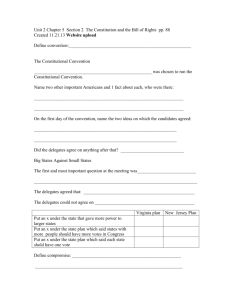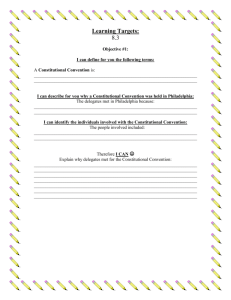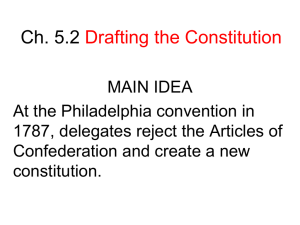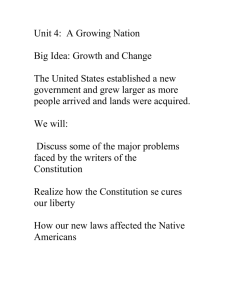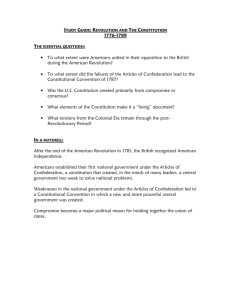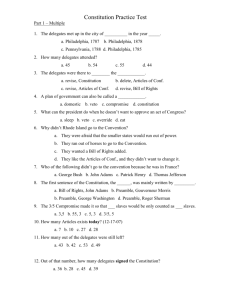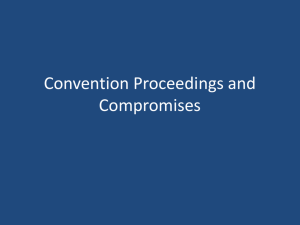US History Fort Burrows 7.2 - The Constitutional Convention READ
advertisement
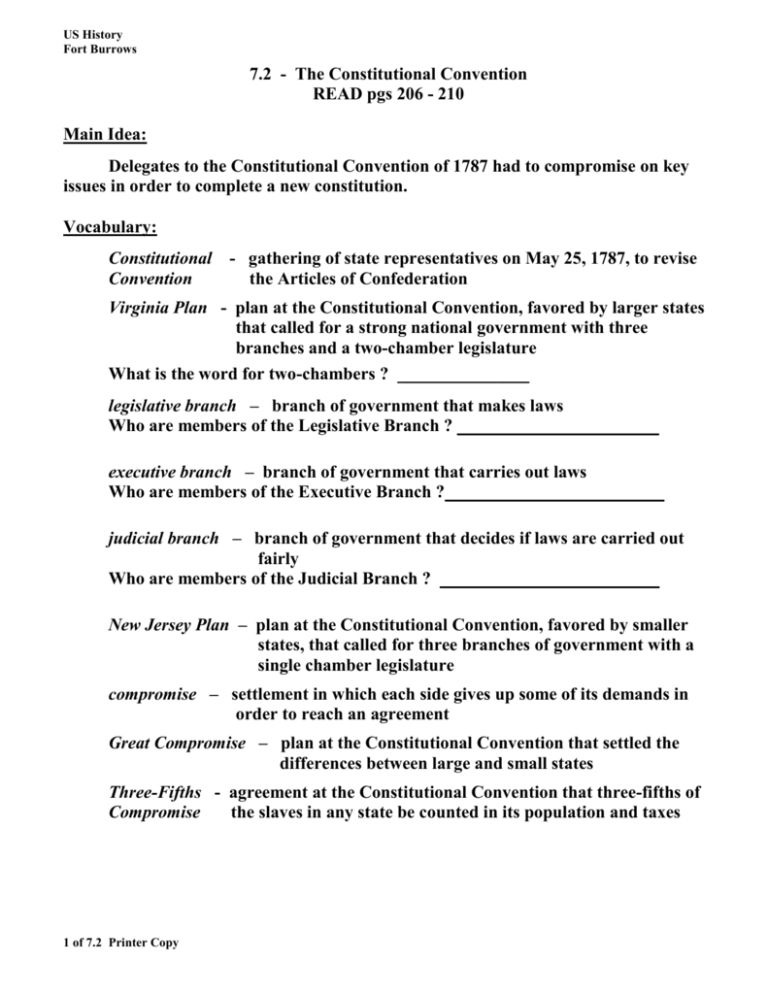
US History Fort Burrows 7.2 - The Constitutional Convention READ pgs 206 - 210 Main Idea: Delegates to the Constitutional Convention of 1787 had to compromise on key issues in order to complete a new constitution. Vocabulary: Constitutional Convention - gathering of state representatives on May 25, 1787, to revise the Articles of Confederation Virginia Plan - plan at the Constitutional Convention, favored by larger states that called for a strong national government with three branches and a two-chamber legislature What is the word for two-chambers ? _______________ legislative branch – branch of government that makes laws Who are members of the Legislative Branch ? _______________________ executive branch – branch of government that carries out laws Who are members of the Executive Branch ?_________________________ judicial branch – branch of government that decides if laws are carried out fairly Who are members of the Judicial Branch ? _________________________ New Jersey Plan – plan at the Constitutional Convention, favored by smaller states, that called for three branches of government with a single chamber legislature compromise – settlement in which each side gives up some of its demands in order to reach an agreement Great Compromise – plan at the Constitutional Convention that settled the differences between large and small states Three-Fifths - agreement at the Constitutional Convention that three-fifths of Compromise the slaves in any state be counted in its population and taxes 1 of 7.2 Printer Copy US History Fort Burrows Setting the Scene: An air of mystery hung over the State House in Philadelphia. All through the hot summer of 1787, the nation’s great leaders passed in and out of the doors. Guards allowed only the delegates to enter. The windows remained closed, to keep passersby from overhearing any debates. Like other Philadelphians, Susannah Dillwyn was curious and excited. She wrote to her father, “There is now sitting in this city a grand convention, who are to form some new system of government or mend the old one.” What would the convention decide? Rumors buzzed. Wrote Dillwyn, “They say it depends entirely upon their pleasure whether we shall in the future have a congress.” For almost four months, Americans waited to learn the fate of their infant republic. The Delegates to the Convention Constitutional Convention opened on May 25, 1787 and its goal was to revise the Articles of Confederation Every state sent representatives except Rhode Island An Amazing Assembly There were 55 delegates and 8 of them signed Declaration of Independence Ben Franklin, age 81, was wise in the ways of government and human nature George Washington, Virginia, was so respected that he was elected president of the convention Nearly half of the delegates were young men in the 30’s – a new generation Alexander Hamilton, NY, had served as Washington’s private secretary during the revolution Hamilton despised the AOC and wanted a strong central government James Madison Madison, age 36 from Virginia, was the best prepared delegate He had read books on history, politics and commerce – tons of research Madison was quiet and shy but had keen intelligence about how to structure a democratic government – very influential on others Madison is called the “Father of the Constitution” ¿¿ What was the goal of the delegates at the Philadelphia Constitutional Convention ? _________________________________________________________________________ _________________________________________________________________________ Secret Debates Delegates decided to keep their talks secret at the convention Wanted to speak minds freely and explore issues without pressures from outside Closed windows kept the debates secret, but made room very hot 2 of 7.2 Printer Copy US History Fort Burrows Two Rival Plans Delegates realized they would have to do more than simply revise the AOC They chose to write an entirely new constitution for the nation but disagreed on what form the new national government would take The Virginia Plan Madison and Edmund Randolph proposed the Virginia Plan which called for a strong national government Virginia Plan would have 3 branches 1. Legislative Branch would make laws 2. Executive Branch would carry out laws 3. Judicial Branch (courts) would decide if laws were carried out fairly Legislature would have 2 houses and seats were awarded based on population – states with larger populations would have more representatives The New Jersey Plan Small states opposed the Virginia Plan fearing that large states could outvote them in Congress William Paterson, from NJ, presented plan that had the support of the smaller states New Jersey Plan called for 3 branches but only 1 house Each state would only have 1 vote regardless of population Plan also gave national government the power to tax and regulate trade The Great Compromise For a while, no agreement could be reached and seemed Convention would fall apart with adopting any plan Roger Sherman, from Connecticut, worked out a compromise he hoped would satisfy both large and small states Sherman’s compromise called for a 2 house-legislature Lower House, House of Representatives (HOR), would be elected by popular vote Seats in HOR would be awarded to each state based on population Upper House, Senate, would be chosen by state legislatures Each state would have two senators On July 16, Sherman’s plan was narrowly approved and became known as the Great Compromise ¿¿ What were the provisions of the Great Compromise ? __________________________________________________________________________ __________________________________________________________________________ __________________________________________________________________________ 3 of 7.2 Printer Copy US History Fort Burrows Northern and Southern States Compromise The Three-Fifths Compromise Southerners wanted to include slaves in the population count for representation but not for tax assessments If slaves were counted, southern states would have more reps in HOR Northerners argued slaves should be counted for tax assessments but not representation Once again, the delegates compromised They agreed that three-fifths (3/5) of slaves would be counted for both taxes and representation If state had 5,000 slaves, 3,000 would be counted ¿¿ What was the purpose of the Three-Fifths Compromise ? __________________________________________________________________________ __________________________________________________________________________ __________________________________________________________________________ The Slave Trade By 1787, some northern states had banned slave trade within their borders Delegates urged that slave trade be banned in the entire nation Southerners warned that a slave ban could ruin their economy Northern and southern states compromised again Congress could not outlaw slavery for 20 years No state could stop a fugitive slave from being returned to the owner Signing the Constitution As the long hot summer drew to a close, delegates struggled with one difficult question after another On September 17, 1787, the Constitution was ready to be signed Its opening lines, or Preamble, expressed the goals of the framers “We the people of the United States, in order to form a more perfect union…” Delegates listened to Benjamin Franklin at the last meeting “I doubt…whether any other Convention…may be able to make a better Constitution… I cannot help expressing a wish, that every member of the Convention who may still have objections to it, would with me, on this occasion, doubt a little of his own infallibility, and … put his name to this instrument.” Benjamin Franklin, Records of the Federal Convention of 1787 One by one, delegates came forward to sign the document 4 of 7.2 Printer Copy US History Fort Burrows All but 3 delegates signed – Randolph, Mason and Gerry refused stating that the Constitution gave too much power to the national government Constitution called for each state to hold a convention to approve or reject the plan Once 9 states endorsed it, it would go into effect ¿¿ What was Franklin’s views regarding the signing of the Constitution ? ______________________________________________________________________ ______________________________________________________________________ ______________________________________________________________________ 1. Who were the leading delegates to the Constitutional Convention ? __________________________________________________________________________ __________________________________________________________________________ __________________________________________________________________________ 2. What were the main differences between the two rival plans for the new Constitution ? Virginia Plan – __________________________________________________________________________ __________________________________________________________________________ NJ Plan – __________________________________________________________________________ __________________________________________________________________________ 3. What 3 compromises did the delegates have to reach before the Constitution could be signed ? 1.________________________________________________________________________ __________________________________________________________________________ 2.________________________________________________________________________ __________________________________________________________________________ 3.________________________________________________________________________ ________________________________________________________________________ 5 of 7.2 Printer Copy



